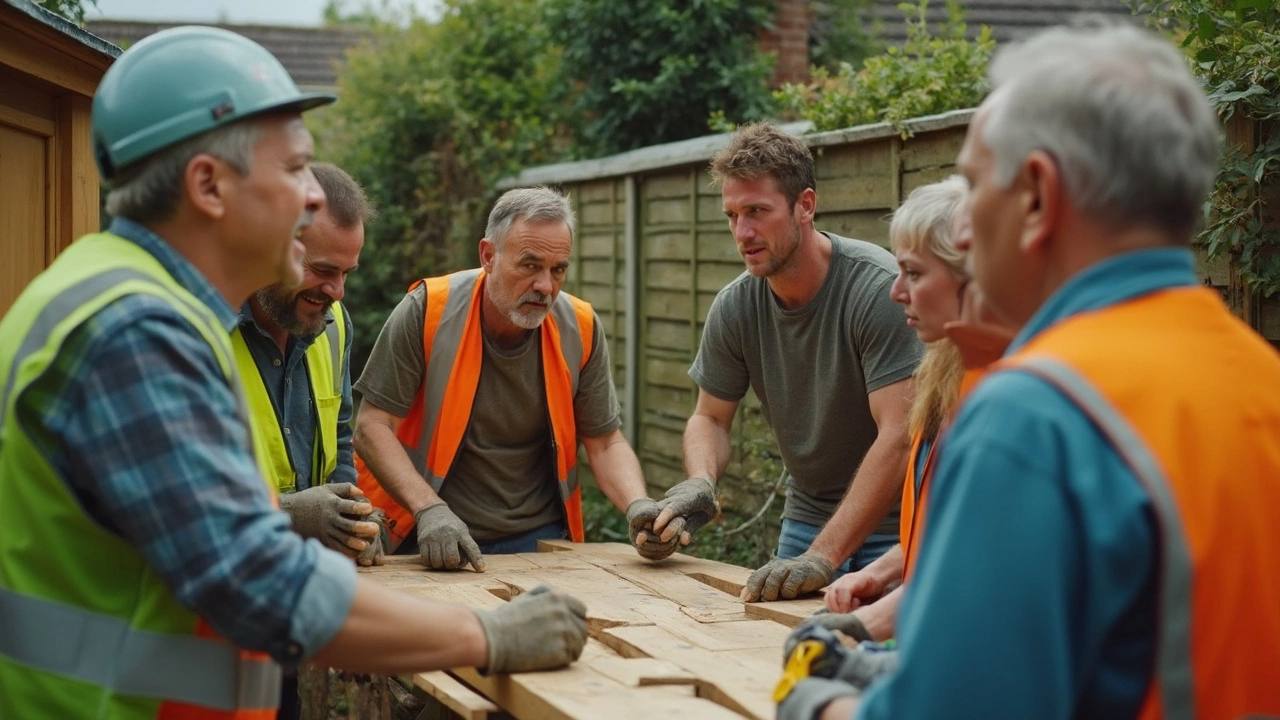Picture this: you've got a leaky faucet, a wobbly shelf, or a busted piece of drywall. Maybe you want to help a friend put in new flooring or finally build that backyard shed you've been eyeing on Pinterest. Guess what? You don't need to be some master craftsman to handle the basics. Most folks overcomplicate things, but the truth is, learning basic construction skills is way more doable than people think.
Start small. Every pro builder started with a single nail, so don't get overwhelmed by talk of blueprints or expensive tools. The real starting point? Curiosity and a willingness to get your hands a little dirty. Whether it's fixing small stuff around your place or just knowing how a power drill works, every bit you pick up makes the next job easier. Plus, there's a sense of pride in actually building or fixing something yourself—no hidden fees, no waiting on contractors, just you and the results.
Before you binge-watch tutorials or buy a toolbox the size of your car, think about what you want to fix or build first. Simple projects are the best teachers. A floating shelf, a basic set of stairs, or even patching a hole in the wall can teach you more than any stack of how-to books. Build that confidence first, then worry about the fancy stuff.
- Why Learn Basic Construction Skills?
- The Tools You Really Need
- Simple Projects to Build Confidence
- Where to Learn: Courses, Apps, and YouTube
- Safety: What Nobody Tells You
- Next Steps: Growing Beyond the Basics
Why Learn Basic Construction Skills?
Think fixing a leak or hanging a door is just for people in overalls? Not even close. Knowing the basics around construction puts you in control of your home, your wallet, and your time.
First up, these skills save you money. Professional repairs get expensive fast, especially with service fees and mark-ups on parts. In a recent survey by the National Association of Realtors, 75% of homeowners said they attempted at least one DIY repair to keep costs down. The stuff you master—patching drywall, installing basic plumbing, using a saw—pays for itself the first time you use it instead of calling a pro.
It’s also a huge boost in confidence. Ever felt frustrated by a broken cabinet or crooked curtain rod? A little hands-on building or repair pulls the rug out from that helpless feeling. When you tackle your own projects, you’re picking up troubleshooting skills no classroom can teach. Suddenly, you’re not lost at the hardware store, and things like loose tiles or creaky floors stop feeling like emergencies.
There’s another perk—not relying on someone else’s schedule or expertise. Emergencies don’t wait for the weekend. If a pipe bursts or a window cracks, you’ll have what you need to stop the problem in its tracks. You even get to be the friend everyone calls when something goes sideways, which is a good feeling most folks underestimate.
- Save money on home repairs
- Avoid waiting around for contractors
- Learn how home systems work
- Boost your problem-solving ability
- Beat the helpless feeling when something breaks
And don’t forget the bigger picture: construction skills are in demand. Even knowing your way around a hammer or drill can translate to side gigs or bigger work down the line. The U.S. Bureau of Labor Statistics reported steady job growth in construction every year since 2012. Whether you’re after DIY independence or considering a career shift, starting with basic skills is the smart move.
| Benefit | Impact |
|---|---|
| DIY Repair | Average savings of $200-$1,000 per project |
| Confidence | 68% of new DIYers report higher self-esteem |
| Job Market | Over 7 million construction jobs in the US (2024) |
If you’re thinking about learning construction skills, you’re setting yourself up for more freedom, less stress, and some serious bragging rights when your latest fix works perfectly.
The Tools You Really Need
If you're just starting out, don't get tricked into spending hundreds at a hardware store. You only need a small set of solid tools to learn construction skills and actually get stuff done. Most first-timers use only a handful over and over. Here’s what you really can’t skip:
- Tape Measure: Nothing happens without this. You’ll need it for every project, from hanging a picture to building a deck.
- Claw Hammer: Classic and straightforward. Get a 16-ounce one—heavy enough for serious jobs, light enough for simple fixes.
- Screwdriver Set: Go for a set with both Phillips and flathead tips. Projects always need both. If you’re buying just one, try a 6-in-1 that switches ends—big time saver.
- Cordless Drill: Way less hassle than a manual screwdriver, and it opens up a ton of projects like shelves, fences, or furniture.
- Pliers and Adjustable Wrench: Pliers grip, twist, and hold just about anything. A wrench gets plumbing and nuts/bolts sorted.
- Utility Knife: These things cut drywall, boxes, rope, insulation—you name it. Always handy.
- Level: Keeps things looking sharp, whether it's a shelf or a picture frame. A two-foot level covers most jobs.
If you end up loving this, you’ll probably want to add a circular saw, stud finder, or speed square, but only after you’ve knocked out a few projects. No sense blowing cash before you know what you’ll use often.
| Tool | Average Price (USD) | How Often Beginners Use It |
|---|---|---|
| Tape Measure | $10–$20 | Daily |
| Claw Hammer | $15–$25 | Several times a week |
| Cordless Drill | $40–$100 | Weekly |
| Screwdriver Set | $10–$30 | Daily |
| Pliers | $10–$20 | Weekly |
| Adjustable Wrench | $15–$25 | Weekly |
| Utility Knife | $5–$15 | Daily |
| Level | $10–$25 | Weekly |
Stick with reliable brands for these basics—Stanley, DeWalt, or Milwaukee rarely let folks down. Don’t overthink it and don’t buy cheap knockoffs; those usually let you down right when you need them. After a few projects under your belt, you’ll know what feels right in your hand and what deserves a little extra investment.
Simple Projects to Build Confidence
Getting your hands dirty is the fastest way to pick up construction skills. You don’t need to jump right into big renovations—there are basic projects that teach you solid skills, cost little, and don’t require much space or expensive gear.
The best starter projects are real-life fixes you’ll actually use. Think fixing a drywall hole, hanging a sturdy shelf, or swapping out a broken door handle.
- Patch a drywall hole: More than 20 million drywall repair products get sold in the U.S. each year. If you’ve ever seen a fist-sized dent in the wall and thought it was game over, think again. Patching kits from the hardware store make it simple. You’ll learn to use a putty knife, sandpaper, and paint for a finish that’s almost invisible.
- Install a floating shelf: Perfect for learning to measure, use a level, find wall studs, and drill with anchors. These skills are used in all kinds of home projects later on.
- Change a light fixture or switch: As long as you switch off the breaker, electrical basics are not as scary as they seem. Just follow instructions, double-check power is off, and you’ll see just how manageable small electrical jobs are.
- Build a simple workbench or storage box: Cutting and screwing together a DIY bench or box teaches you how materials go together and how to use tools like saws and drills, plus how to read a basic plan.
Don’t try to tackle too much at once. As Mike Holmes (a contractor with his own shows) says:
If you start simple and get it right, your confidence will build. Rushing or skipping the basics just leads to bigger headaches later.
Here’s a quick look at which tools and skills you’re likely to use in your first few projects:
| Project | Main Tools Needed | Skills Learned |
|---|---|---|
| Patch Drywall | Putty knife, sanding block, paintbrush | Surface prep, patching, painting |
| Install Shelf | Drill, level, stud finder | Measuring, drilling, anchoring |
| Change Light Fixture | Screwdriver, voltage tester | Basic wiring, safety |
| Build Workbench | Handsaw, drill, tape measure | Cutting, fastening, planning |
Tackling these beginner-friendly projects helps you learn by doing. You’ll make mistakes—and that’s actually a plus. Each time you mess up and fix it, you get better. By the time you move on to bigger things, you’ll have the basics locked in without feeling lost.

Where to Learn: Courses, Apps, and YouTube
Okay, time to get real about where folks actually pick up construction know-how. If you wanna learn construction skills, you have more choices now than our dads ever did. No need to enroll in a four-year trade school just to hang a door.
Let’s break down the best spots—online and offline—where you can start learning:
- YouTube: This is the go-to for most people. Search for almost anything (“how to tile a bathroom,” “framing a wall,” you name it) and you’ll find a solid video. Channels like Home RenoVision DIY, This Old House, and Essential Craftsman have easy-to-follow projects and a ton of tips. Be picky—check the likes and comments to spot bad advice.
- Home Improvement Stores: Big chains like Home Depot and Lowe’s offer free weekend workshops. You get hands-on time with tools and pros guiding you. Sure, it’s basic, but perfect for beginners who wanna try before they buy expensive tools.
- Online Courses & Apps: Websites like Skillshare, Udemy, and even Coursera have beginner construction and carpentry courses you can do at your own pace. Some apps like DIYZ and iHandy Carpenter toss in project instructions, calculators, and handy diagrams right on your phone.
- Community Colleges and Trade Schools: If you want something a bit more serious, short evening classes let you learn framing, drywall, or even electrical basics with real instructors. You’ll usually get to practice under supervision, which means fewer dumb mistakes.
Here’s a quick table showing what real people use and what they pay for it:
| Learning Source | Free? | Hands-On? | Self-Paced? |
|---|---|---|---|
| YouTube | Yes | Sometimes | Yes |
| Home Store Workshops | Yes | Yes | No (scheduled classes) |
| Online Courses | No (usually $10-$50) | No | Yes |
| Community College | No ($50-$200+) | Yes | No (class schedule) |
One tip: Mix it up. Watch a YouTube video, then try a free workshop, then dive into an online lesson. The more ways you try learning, the faster it sticks. And when you get stumped? Everybody starts there—just keep poking around till the pieces make sense.
Safety: What Nobody Tells You
No one likes to talk about what goes wrong on the job, but ignoring safety in construction skills is a surefire way to end up injured or out of work. In fact, most home accidents involving tools aren't caused by big, dramatic mistakes—it's the small stuff. A 2023 report from the National Safety Council found that nearly 40% of DIY injuries involved falls from ladders less than six feet high. It’s not the mega-builds that’ll get you, but day-to-day slips and shortcuts.
Start by respecting your tools. Power saws, drills, and even basic hammers deserve your attention. Always check that your equipment is in good shape—a dull blade or frayed cord is a problem waiting to happen. Never wear jewelry or loose sleeves when working; they can catch in spinning parts before you even know what’s hit you. Safety glasses and earplugs may seem annoying, but a flying nail or a sudden whine from a circular saw can do real damage.
- Always shut off power at the breaker before messing with any electrical work.
- When working above shoulder height, keep both feet flat on a stable surface. No tiptoes on chairs—use a ladder and lock it in place.
- Don’t lift more than you can carry safely. Ask for help or break up the load if it’s too heavy.
- Keep your workspace clean and well-lit. Most trips and falls happen because of scattered tools or hidden cords.
Here’s a quick glance at the most common injuries beginners face and how to dodge them:
| Injury Type | Main Cause | How to Prevent |
|---|---|---|
| Cuts & Punctures | Improper tool use | Always cut away from your body, keep blades sharp |
| Falls | Unstable ladders or messy areas | Use proper ladders, clear the floor before starting |
| Eye Injuries | Flying debris | Wear safety glasses every time you cut or drill |
| Electric Shock | Touching live wires | Shut off breaker, double-check with a voltage tester |
One last thing: you’re never too cool for safety gear. Even the pros admit they’ve avoided nasty injuries by just throwing on a pair of gloves or dust mask at the right time. Nobody looks tough in the ER. Make safety part of your habit, not an afterthought.
Next Steps: Growing Beyond the Basics
So you’ve got those first few projects under your belt—maybe you cut a few straight lines, drove some screws like a champ, and didn’t even split the wood (much). Now it’s time to level up. Keep that momentum! There’s a ton of ways to sharpen your construction skills and move past the basics. The cool part is, even just learning one new thing–like tiling, framing, or reading blueprints–can open up a whole new world of projects you never thought you’d tackle.
If you’re up for more serious projects, stuff like building a simple deck, installing a door, or wiring an outlet isn’t out of reach. But you’ve got to know what you’re doing, especially when those projects involve safety or complex codes. A lot of city and state websites give out free building guides, so check those before you buy supplies. For anything involving plumbing or electricity, double-check your local regulations or call in an expert for the serious stuff.
Here’s what you can do to keep growing:
- Pick one new skill each month—maybe drywall taping one month, then laying tile the next.
- Find a mentor. This could be a neighbor, a friend, or even someone you meet in online construction forums like r/HomeImprovement on Reddit.
- Take short, focused classes. Community colleges, tool libraries, and even many hardware stores offer hands-on, affordable workshops.
- Study up on building codes and permits, especially if you want to add walls, move plumbing, or work with wiring. Getting this stuff wrong can be costly.
- Keep a photo log of your work. It’s awesome for tracking progress and can be a lifesaver if you need to troubleshoot later.
Don’t be afraid to make mistakes—just learn from them so you don’t repeat them on bigger, pricier materials. Pros mess up too. The key is to fix it right and move forward.
Want to see where most beginners head next? Check this out:
| Skill | Time to Learn | Common Project |
|---|---|---|
| Tiling | 2-3 weekends | Backsplash upgrade |
| Simple Framing | 1 weekend | Building a partition wall |
| Door Hanging | 1 weekend | Replacing an interior door |
| Basic Wiring | 3-4 days (plus code review) | Swapping light fixtures |
| Installing Drywall | 2 weekends | Finishing a basement room |
As you add tools to your setup and skills to your game, you’ll start seeing the house not just as a place to live, but as something you can shape, fix, and improve yourself. Don’t rush, always work safe, and have fun with the process—it’s the best way to truly get good at building.





Write a comment